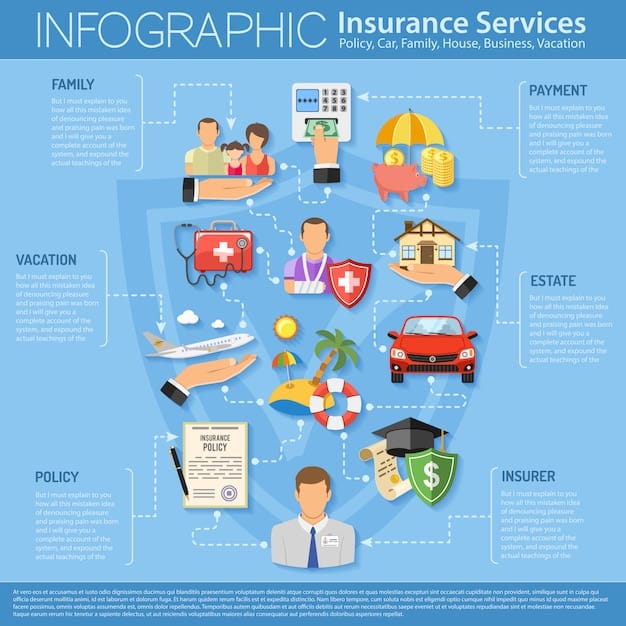Affordable Care Act 2025: Enrollment, Deadlines, and Coverage

Affordable Healthcare Act Updates: Enrollment Deadlines and Coverage Options for 2025 provide crucial information for individuals and families seeking health insurance, outlining key enrollment dates, available coverage choices, and potential financial assistance to make healthcare accessible and affordable.
Understanding the Affordable Healthcare Act Updates: Enrollment Deadlines and Coverage Options for 2025 is essential for Americans seeking affordable health insurance. This guide clarifies the key dates, coverage choices, and available assistance to help you navigate the process with confidence.
Affordable Care Act: Key Updates for 2025
The Affordable Care Act (ACA), also known as Obamacare, continues to evolve, bringing changes that impact enrollment deadlines and coverage options for 2025. Staying informed about these updates is crucial for individuals and families who rely on the ACA for their health insurance needs.

Understanding the Open Enrollment Period
The Open Enrollment Period is the annual window when individuals can enroll in or change their health insurance plans through the Health Insurance Marketplace. Missing this deadline can limit your options for coverage.
- Open Enrollment typically runs from November 1st to January 15th in most states.
- Deadlines can vary by state, so it’s important to check your state’s specific dates.
- Enrolling by December 15th ensures coverage begins on January 1st of the following year.
Staying on top of these deadlines ensures you have continuous coverage without gaps. Plan ahead and gather all necessary documents to make the enrollment process smooth.
Enrollment Deadlines to Remember for 2025
Navigating the enrollment process requires a keen eye on deadlines. Understanding when you need to act is essential to securing coverage under the Affordable Care Act.
Key Enrollment Dates for 2025 Coverage
For 2025 coverage, it’s important to keep these dates in mind to avoid any lapses in your health insurance.
- November 1, 2024: Open Enrollment begins for the Health Insurance Marketplace.
- December 15, 2024: Deadline to enroll for coverage that starts January 1, 2025.
- January 15, 2025: Open Enrollment ends in most states.
Special Enrollment Periods
Outside the Open Enrollment Period, you may still be able to enroll in a health plan if you qualify for a Special Enrollment Period (SEP). This is triggered by certain life events.
Qualifying life events include:
- Losing health coverage due to job loss or changes in eligibility.
- Getting married or divorced.
- Having a baby or adopting a child.
- Moving to a new state.
To enroll through a SEP, you typically need to provide documentation verifying the qualifying event, and you usually have 60 days from the event to enroll.
Exploring Available Coverage Options
The Health Insurance Marketplace offers a variety of health plans to suit different needs and budgets. Familiarizing yourself with the different types of plans available is a key step in choosing the right coverage.
Types of Health Insurance Plans
Understanding the different types of plans can help you make an informed decision about which one best meets your needs.
Here are the primary types of plans available:
- Health Maintenance Organization (HMO): Typically offers lower premiums but requires you to choose a primary care physician (PCP) and get referrals to see specialists.
- Preferred Provider Organization (PPO): Offers more flexibility, allowing you to see specialists without a referral, but usually comes with higher premiums.
- Exclusive Provider Organization (EPO): Similar to an HMO but doesn’t require a PCP referral. However, coverage is limited to providers within the EPO network.
- Point of Service (POS): Combines features of HMOs and PPOs, requiring you to choose a PCP but allowing you to go out-of-network for care, often at a higher cost.

Comparing Plans Effectively
When comparing plans, consider not only the monthly premium but also the deductible, copayments, and coinsurance. These factors will influence your out-of-pocket costs.
To compare plans effectively, consider these tips:
- Estimate your healthcare usage for the year.
- Check the plan’s provider network to ensure your preferred doctors are included.
- Review the plan’s summary of benefits and coverage (SBC) for detailed information.
Understanding Financial Assistance Programs
One of the key features of the Affordable Care Act is the availability of financial assistance to help lower the cost of health insurance. Understanding these programs and how to qualify can make coverage much more affordable for many individuals and families.
Premium Tax Credits
Premium Tax Credits are designed to lower your monthly premium payments. The amount of the credit is based on your estimated household income and family size. To be eligible, your income must fall within a certain range relative to the Federal Poverty Level (FPL). These tax credits can be applied directly to your monthly premium, reducing the amount you pay out-of-pocket.
- Income eligibility is crucial; consult the latest guidelines to determine if you qualify.
- Tax credits are calculated based on the cost of the benchmark plan (the second-lowest cost silver plan in your area).
- You can estimate your potential tax credit using the Health Insurance Marketplace calculator.
Cost-Sharing Reductions (CSRs)
Cost-Sharing Reductions (CSRs) help lower your out-of-pocket costs, such as deductibles, copayments, and coinsurance. These reductions are available to individuals and families with incomes that fall within a certain range of the Federal Poverty Level, who also enroll in a silver-level health plan. CSRs can significantly reduce the financial burden of healthcare by lowering the amount you pay each time you receive care.
- CSRs are available only with silver-level plans.
- Eligibility depends on your income and family size.
- CSRs can greatly reduce your annual deductible and copayments.
How to Enroll in an ACA Health Plan
Enrolling in an ACA health plan involves several steps, from gathering necessary information to selecting the right plan and completing the application. This section is a guide for navigating this process efficiently.
Step-by-Step Enrollment Guide
Follow these steps to enroll in an ACA health plan:
- Gather necessary information, including your Social Security number, income information, and policy numbers for any current health insurance.
- Visit the Health Insurance Marketplace website for your state or the federal marketplace at HealthCare.gov.
- Create an account or log in if you already have one.
Tips for a Smooth Enrollment Process
Consider these tips for a seamless enrollment experience:
- Start early to avoid last-minute rushes and potential website issues.
- Compare multiple plans to find the one that best suits your needs and budget.
- Provide accurate information on your application to avoid delays or complications.
Resources for Further Assistance
Navigating the Affordable Care Act can be complex, and it’s helpful to know where to turn for additional assistance. Numerous resources are available to provide guidance and support throughout the enrollment process.
Navigators and Enrollment Assisters
Navigators and Enrollment Assisters are trained professionals who can help you understand your coverage options, complete the application process, and answer any questions you may have. They provide free, unbiased assistance and can be found in communities across the country.
- Navigators offer in-person assistance and can guide you through the entire enrollment process.
- Enrollment Assisters can help you understand eligibility requirements and find the best plan for your needs.
- Contact your local Health Insurance Marketplace to find Navigators and Enrollment Assisters in your area.
Online Resources and Tools
Numerous online resources are available to provide information, tools, and calculators to help you make informed decisions about your health coverage. These resources can help you estimate your potential tax credits, compare plans, and understand the details of your coverage.
- HealthCare.gov provides a wealth of information about the Affordable Care Act and the Health Insurance Marketplace.
- The Kaiser Family Foundation offers resources and tools to help you understand health policy and insurance options.
- Your state’s Health Insurance Marketplace website provides state-specific information and resources.
| Key Point | Brief Description |
|---|---|
| 🗓️ Enrollment Dates | Open Enrollment is Nov 1 – Jan 15; Dec 15 for Jan 1 coverage. |
| 💰 Financial Assistance | Premium Tax Credits and Cost-Sharing Reductions can lower costs. |
| 🩺 Coverage Options | HMO, PPO, EPO, and POS plans offer varied access and costs. |
| ❗ Special Enrollment | Life events like job loss can trigger a Special Enrollment Period. |
Frequently Asked Questions
▼
The open enrollment period typically runs from November 1st to January 15th in most states, but be sure to check your state’s specific dates as they may vary.
▼
A Special Enrollment Period allows you to enroll outside the regular open enrollment due to qualifying life events like losing coverage, marriage, or moving.
▼
Premium Tax Credits are available to lower your monthly premiums. Eligibility is based on your income and family size; you can apply through the Health Insurance Marketplace.
▼
Cost-Sharing Reductions lower your out-of-pocket costs for deductibles, copayments, and coinsurance and are available to those with qualifying incomes enrolling in silver plans.
▼
The ACA Marketplace offers plans like HMOs, PPOs, EPOs, and POS plans, each providing different levels of flexibility, provider networks, and out-of-pocket costs.
Conclusion
Staying informed about the Affordable Healthcare Act updates for 2025 is essential for securing affordable and comprehensive health coverage. By understanding enrollment deadlines, exploring different coverage options, and taking advantage of available financial assistance, you can navigate the ACA with confidence and ensure you and your family have access to the healthcare you need.





